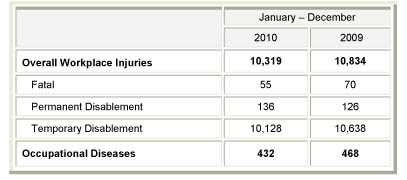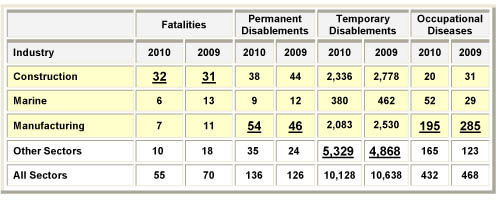Singapore’s overall 2010 WSH performance improved, with lowest recorded fatality rate in 6 years
16 March 2011
- In the latest Workplace Safety and Health (WSH) Statistics Report issued by the WSH Council and Ministry of Manpower, the overall number of workplace fatalities, injuries and occupational diseases (ODs) fell across the board in 2010. The number of workplace fatalities dropped from 70 in 2009 to 55 in 2010, leading to the lowest-ever workplace fatality rate of 2.2 per 100,000 employed persons since 20041. Workplaces were more productive in 2010 as they saw a 20% reduction in man-days lost due to work incidents2. While most sectors have improved, the construction sector is a cause for concern, accounting for more than half of all work fatalities.
Overview of Report
- In addition to the 20% drop in workplace fatalities, overall workplace injuries also fell by 4.8%. Occupational diseases (ODs)3 dropped about 8% from 468 cases reported in 2009 to 432 cases in 2010. The majority of OD cases (84%) continued to be attributed to Noise-induced Deafness. Please refer to Table 1.
Table 1: Number of Workplace Injuries and Occupational Diseases, 2009 and 2010

- The accident severity rate4 (or ASR) also fell in 2010 to 87 man-days lost for every million man-hours worked, a significant improvement compared to 112 in 2008 and 2009 (See Table 2). This shows that injuries were less severe, hence, contributing to the 20% drop in man-days lost due to work incidents.
Table 2: Workplace Accident Severity Rate, 2006 – 2010
| |
2006 |
2007 |
2008 |
2009 |
2010 |
| ACCIDENT SEVERITY RATE (ASR) |
125 |
116 |
112 |
112 |
87 |
Sector-specific overview
- The three traditionally higher risk sectors (Construction, Marine and Manufacturing) accounted for about 80% of fatalities and permanent disablements. The Construction sector continued to be the top contributor of work fatalities this year while the Manufacturing sector was the top contributor of permanent disablements and occupational diseases (or about 40% of cases in both). In terms of temporary disablements, other sectors (such as logistics, hotels and restaurants, wholesale and retail) accounted for more than half of the cases. The full WSH Statistics Report is in Annex A.
Table 3: Number of Workplace Fatalities by Industry, 2009 and 2010

- Mr Lee Tzu Yang, Chairman of the WSH Council, spoke on the report’s significance. He said, “The WSH performance last year is encouraging. We see fewer injuries and with that, a lower fatality rate. Less productive time was lost to work incidents, ensuring less disruption to businesses while keeping more workers safe. The Council believes the growth and intensity of industry engagement in WSH over the recent years has contributed to this, as over 300,000 people were trained annually and more than 8,000 companies embarked on WSH initiatives. While we are headed in the right direction, our journey is never complete. The Council calls on industry and workers to continue our efforts together to consistently bring down the injury and fatality rates year after year.”
- While agreeing that the overall decline in injuries and fatalities last year is a good development, MOM’s WSH Commissioner Ho Siong Hin cautioned on the need to stay vigilant, “We know that our workplace fatality numbers are volatile. A single incident could cause a spike in numbers. We must step up efforts to improve WSH practices across the board. In particular, the construction sector must take quantum leaps. We are concerned with the persistent safety lapses, especially those that lead to fatalities, such as work-at-height and falling objects. I urge parties to take full responsibility for safety and work closely with the WSH Council. Those who blatantly disregard the safety of their workers will be severely dealt with.”
- Industry stakeholders who want to find out more can visit the MOM website and WSH Council website.
1 Singapore started measuring the workplace fatality rate from the Year 2004, following the introduction of the new OSH framework.
2 In 2009, 663,657 man-days were lost due to work incidents. This fell to 526,774 man-days lost in 2010.
3 Occupational Disease (ODs) are illnesses that are directly caused by physical, chemical or biological hazards in the workplace. There are 31 reportable ODs under the Third Schedule of the WSH Act.
4 The ASR measures the number of mandays lost due to work incidents for per million manhours worked.
Annex A - Workplace Safety and Health Report 2010